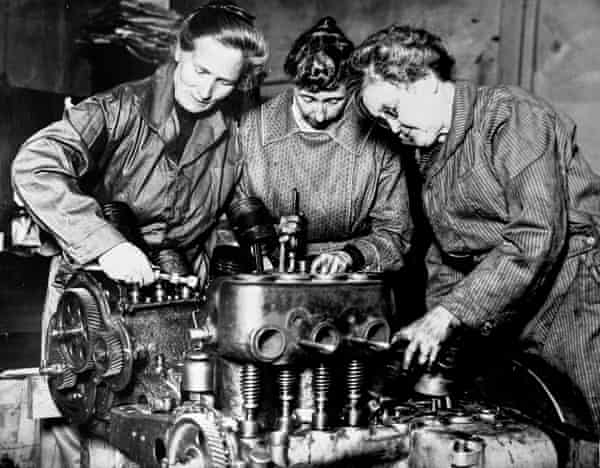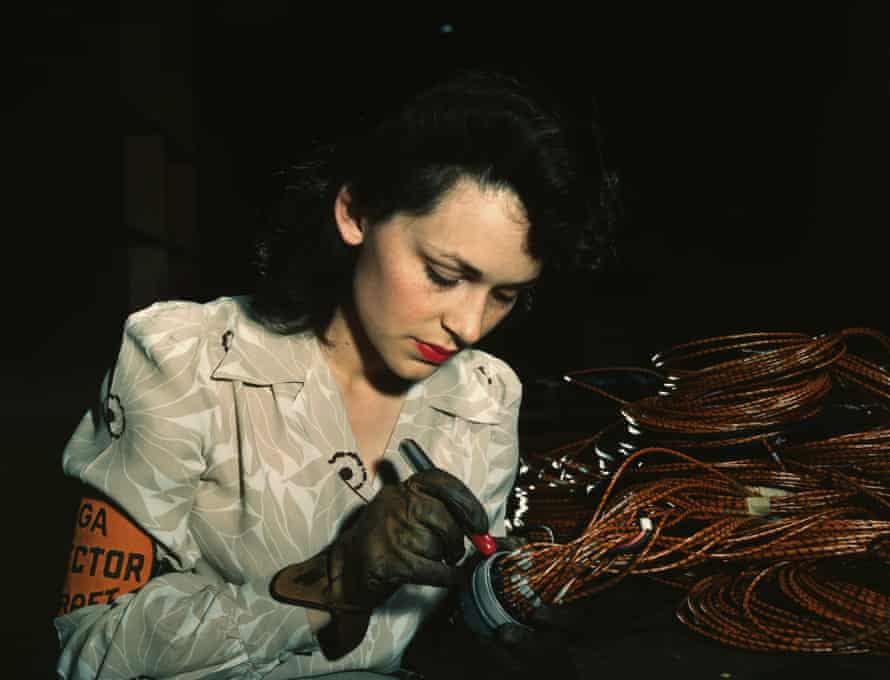Picture of Women Wearing Shirts That Say Make America White Again
R egulating how women dress, both in and out of the workplace, is nothing new. In ancient Greece, an appointed group of magistrates, gynaikonomoi, or "controllers of women", ensured that women dressed "appropriately" and managed how much they spent on their wearing apparel. The strict – and mandatory – codes were designed to remind women of their place in Greek guild. In the ensuing millennia, not much has inverse. Throughout history, men accept controlled women's bodies and their clothing by way of social strictures and laws.

Employers have long imposed dress codes on women in the workplace, enervating that women wear, for instance, high heels, stockings, makeup and dresses or skirts of an appropriate simply feminine and attracting length. Employers take also mandated how women should wear their pilus. Women of color, and black women in particular, take faced discrimination in the workplace when they choose to habiliment their hair in natural styles or braids. Employers take also tried to constrain what women habiliment past discriminating against religion-based practices, barring, for instance, Muslim women from wearing the hijab.
In the early 20th century, women began entering the workforce en masse. But only women who worked in factories, on farms or in other forms of manual labour had the flexibility to wear clothing such every bit trousers. Women who worked in offices had to wear the skirts, heels and jewellery expected of their sexual activity. This division would keep until the 1970s, when the influence of the sexual revolution made its mark. Although women still had to arrange to social mores, they now had the freedom to consider personal comfort and style in what they wore in the workplace.

Throughout the 1980s and early on 1990s, women often wore trousersuits, like their male counterparts. In Mode Talks: Undressing the Power of Fashion, author and professor Shira Tarrant notes that "with the dress for success and the yuppie era with Reagan in office, women were starting to go MBAs. They were going to crack the glass ceiling and, in order to do so, they wore the big shoulder pads and the shirts that have an homage to men's ties." Although this fashion soon fell out of fashion, a more gimmicky version was embraced over again by Democratic nominee Hillary Clinton in the 2016 presidential ballot and the outfit became a rallying symbol for women eager to see a female president. Feminism has made incredible gains and, today, what women vesture in the workplace is as varied as the piece of work women do. All the same, the patriarchal standards for women's appearances remain deeply embedded in our culture. In 2010, the Swiss depository financial institution UBS came under burn down after word leaked of its 44-page dress code, replete with guidelines on applying makeup, keeping toenails trim to avert tearing stockings, avoiding overly tight shoes that might cause women to have "strained" smiles, and wearing flesh-toned underwear and then that a woman'southward underclothes remain a matter of discretion rather than spectacle.

Only in 2012 were women in the Regal Canadian Mounted Constabulary allowed to habiliment trousers on full apparel occasions. In 2017, the United States congressional dress lawmaking however banned women – congressional staffers and visitors, such as journalists – from wearing sleeveless tops. A journalist was even turned abroad from a room exterior the House chamber considering her outfit, which bared her arms, was deemed "inappropriate". That same year, President Donald Trump, co-ordinate to a source, alleged that female staffers in the White Firm should "dress similar women". While about employers also accept wearing apparel codes for men, requiring them to clothing suits and ties, keep their hair and beards trimmed, and so on – those codes symbolise a notion of professionalism, rather than cultural expectations of masculinity. As in so many things, the rules are unlike for women. To dress similar a woman is to dress in very prescribed ways that heighten a rigid brand of femininity and cater to the male person gaze. To dress similar a woman suggests that women are simply decorative elements in the workplace. To dress like a woman is to ignore that women have independent and diverse notions of how they wish to present themselves to the world.
I have never been proficient at dressing like a woman. I stopped wearing dresses when I was 12 years sometime. I am 1.9m tall (6ft 3in), so if I were to wear high heels, I would tower over people more I already do. I clothing makeup only if I actually have to because, for any reason, I never quite learned how to exercise it myself. And, when I was 19, I started getting tattoos up and down my arms – hardly the marker of traditional femininity. Throughout my early 20s, I held a series of odd jobs, and what I wore to work ranged from pyjamas (when I worked from abode) to jeans and black T-shirts (when I worked as a bartender). Toward the end of my 20s, I entered the traditional workplace and wore long-sleeved shirts to hibernate my artillery and clothes slacks that I hoped conveyed my competence and professionalism. And, e'er, I felt out of identify because I was not dressing – and did not want to dress – similar a adult female in the expected sense. In graduate schoolhouse, I causeless that, when I became a professor, I was going to have to wear suits to work, that I was going to have to look the function of someone with a PhD, someone qualified to pb a classroom. I quickly realised that there was no standard expect to this function. I had colleagues who taught in dirty T-shirts and paint-splattered jeans. They were, as you might expect, men who knew their authority would non be questioned regardless of what they were wearing. My female colleagues, more often than not younger and petite, always wore such things as dressy blouses and blazers considering they knew their dominance would exist questioned by virtue of their gender, stature and clothing choices. As a alpine woman of an imposing size in her early 40s, I by and large teach in jeans and long-sleeved dress shirts, sometimes overpriced T-shirts.

I habiliment clothes that let me to feel comfortable and confident. That is how I cull to dress like a woman. I have always been enlightened that the freedom to wear mostly what I want has been influenced, in large role, by the women who worked before me – women who, throughout history, refused to let their ambitions to be constrained by narrow ideas of what it means to dress like a adult female. Dress has evolved as the role of women in contemporary society has evolved. Sometimes, dressing like a woman ways wearing a trousersuit; other times, it means wearing a wetsuit, or overalls, or a lab coat, or a constabulary compatible. Dressing like a adult female means wearing anything a adult female deems appropriate and necessary for getting her job done.
This is an excerpt from the foreword to Dress Similar a Woman: Working Women and What They Wore, which is published on 27 Feb by Abrams, £xviii.99. Guardian bookshop price, £16.14 .
Source: https://www.theguardian.com/lifeandstyle/2018/feb/19/roxane-gay-clothes-workplace-female-employees